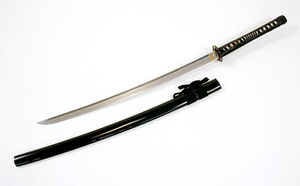Difference between revisions of "Sword"
| Line 12: | Line 12: | ||
* Chainswords ([[Warhammer 40,000]]) | * Chainswords ([[Warhammer 40,000]]) | ||
* Folding swords (seen in ''Ultraviolet'' and ''[[Star Trek (2009)]]'') | * Folding swords (seen in ''Ultraviolet'' and ''[[Star Trek (2009)]]'') | ||
* [[Klingon]] [[bat'leth]]s ([[Star Trek]]), which have similar symbolic meaning in Klingon culture, even though they don't really resemble swords, and some Klingon warriors use actual swords. | * [[Klingon]] [[bat'leth]]s ([[Star Trek]]), which have similar symbolic meaning in Klingon culture, even though they don't really resemble swords, and some Klingon warriors use actual swords such as Mek'leths. | ||
[[Category: Real Technology]] | [[Category: Real Technology]] | ||
[[Category: Small Arms]] | [[Category: Small Arms]] | ||
Revision as of 07:05, 18 March 2010
Swords are a type of long, metal, blade weapon. Swords first emerged in the Bronze Age and remained a primary weapon of war until the widespread use of firearms gradually made them obsolete. They still feature prominently in many militaries as ceremonial items.
Swords are the first, if not the only, human hand tools designed exclusively for killing other human beings. Knives, axes, spears, bows, and firearms all have legitimate alternative uses for hunting or gathering, but swords are really only useful in battle. As such, they have have acquired a great deal of symbolic meaning in human culture.
Swords in Fiction
Obviously swords figure prominently in fantasy writings, but they are also quite common in science fiction. Science fiction swords typically have special technology to make them more dangerous than a mundane steel sword.
Examples of sci-fi swords include:
- Lightsabres (Star Wars)
- Power swords (Warhammer 40,000)
- Chainswords (Warhammer 40,000)
- Folding swords (seen in Ultraviolet and Star Trek (2009))
- Klingon bat'leths (Star Trek), which have similar symbolic meaning in Klingon culture, even though they don't really resemble swords, and some Klingon warriors use actual swords such as Mek'leths.
